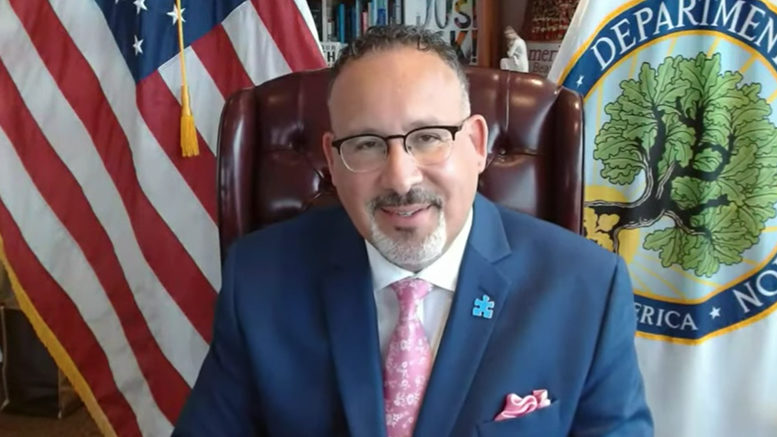The U.S. education secretary would like to see more innovative collaborations between K-12 and community colleges to serve students, including adult learners.
For example, high schools with labs and other hands-on learning spaces could allow community colleges to use their facilities after school hours to reach more adult learners, especially those who want to upgrade or learn new trade skills to get a credential, U.S. Education Secretary Miguel Cardona told House appropriators Wednesday.
“That’s one of my goals: To make sure we are doing a better job creating pathways not only for our students, but for our adults who want another opportunity at learning,” Cardona said during a hearing about the president’s 2022 budget proposal for education.
Related article: Cardona: Connecting the education and workforce systems
Career and technical education (CTE) plays a critical role in many communities that don’t have a high percentage of four-year college graduates, said Rep. John Harder (D-California). That’s critical in the district he serves, where 83% of adults don’t have a college degree, he said.
Harder said that plans to re-introduce his Trades and Career Education Skills Package.
“That package is very focused on trying to create more opportunities for hands-on career education, starting in elementary school, going on through high school and community college, and really focusing on partnerships with local industries to make sure those students are learning locally relevant skills,” he said.
Cardona, who attended a technical high school, said he understands the importance of providing students with options to various careers and connecting them with local workforce needs.
Introducing CTE at an earlier age
Harder noted that nontraditional adult learners often don’t have access to the same student aid as younger learners attending traditional colleges. When asked if he would consider expanding eligibility for Pell grants or other types of aid to adult learners, the secretary said he is reviewing options, though he supports offering more flexibility.
“We have to make sure we’re nimble to meet the demands that are out there and the needs of our learners,” Cardona said. “I would be in support of reviewing that a little bit more and getting more perspective on that (and) making sure we are serving our students the best we can.”
Harder also questioned the secretary about exposing students to CTE options earlier in school in order to promote career readiness. Cardona again said he supports that, noting it not only improves career readiness but also student engagement and learning. He added that students can go on field trips to local businesses, such as advanced manufacturing or STEM-related companies.
He also encouraged businesses to get more involved in local education.
“Why not focus on getting some of our workforce partners on our boards of education to help shape the policy at the local level?” Cardona said.
Women in STEM careers
The hearing also addressed K-12 issues and other higher education topics, such as student loan debt and Title IX, including sexual assaults on campuses and transgender athletes. Several lawmakers noted the importance of finding ways to improve the pipeline for more teachers and mental healthcare workers. Rep. Chuck Fleischmann (R-Tennessee) asked Cardona how ED can encourage more girls and women to consider STEM careers, especially in rural and low-income communities.
“It is imperative that we support public-private partnerships to close the skills gap and cultimate a diverse workforce,” Fleischmann said.
Cardona agreed, reiterating that pathways to develop those careers should be developed as early as middle school, and that those discussions must include K-12, postsecondary institutions and workforce partners, especially on a regional level.
“Regionally, really, is where we can get the most bang for our buck,” he said. “When we know what the needs are regionally, we can make internship experiences together, we can develop curriculum with our partners in the workforce. There’s a lot of room for growth there in this country.”
Kudos to Sauk Valley
Cardona also recognized Sauk Valley Community College (Illinois) which he visited last month with First Lady Dr. Jill Biden. Rep. Cheri Bustos (D-Illinois) thanked the secretary for the visit to the college in her district, where she asked him to consider ways to help fill a teacher shortage in the state (about 4,200 unfilled positions).
“Sauk Valley gets it right,” Cardona said. “If you want to see an example of how a community college could lift a community and provide pathways for careers that exist now, visit Sauk Valley. … It was one of the best visits I’ve had.”
GOP balks at cost
Republicans on the education appropriation committee said the president’s overall $103 billion budget proposal — $30 billion more than the current funding level — is too expensive, especially in light of how much the federal government has already invested in pandemic relief funding for schools and colleges.
“A proposed 41% increase from the Department of Education in a single year will leave the next generation saddled with the highest national debt our nation has ever seen,” said Ranking Member Rep. Tom Cole (R-Oklahoma).
Cole said there are areas that both sides can agree on, such as increases for Pell grants and TRIO programs, which he has long supported.
“Sometimes old tools are good tools,” he said of TRIO.

